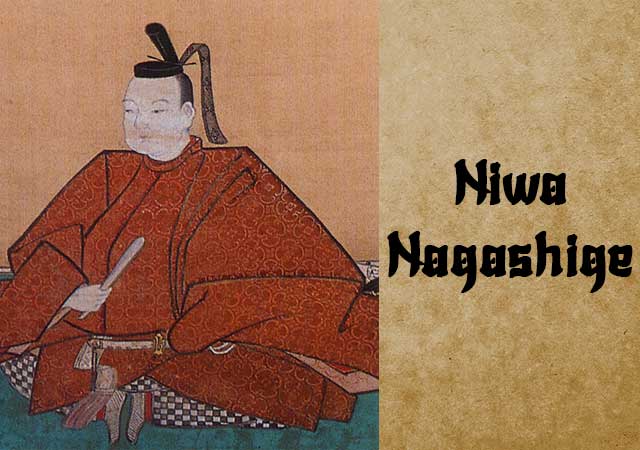Niwa Nagashige, the eldest son of the loyal general Niwa Nagahide under Oda Nobunaga, entered the realm of warfare at the tender age of 12. His initial taste of battle occurred alongside his father during the confrontation against Shibata Katsuie under Toyotomi Hideyoshi at the Battle of Shizugatake. In the following year, at the age of 13, Nagashige stepped into the shoes of his ailing father and led the Niwa army at the Battle of Komaki-Nagakute.

Tragedy struck at the age of 14 when Niwa Nagashige found himself thrust into the position of the head of the Niwa clan and in charge of his father's extensive 1,230,000 koku estates following Nagahide's passing. While Nagashige's father was wed to an adopted daughter of their master, Oda Nobunaga, Nagashige's union was with Ho-onin, the actual 5th daughter of Nobunaga.
The shifting tides of power and alliances brought challenges to Nagashige's legacy. Accused of treachery during the 1585 attacks on the Toyama region, Toyotomi Hideyoshi demoted Nagashige from 1,230,000 koku to a mere 150,000 koku. Further setbacks occurred two years later during the Kyushu subjugation, with Nagashige's income reduced to a meager 40,000 koku. However, his valor at the Siege of Odawara led Hideyoshi to restore his fortunes, elevating his income to 120,000 koku.
Remaining loyal to the Toyotomi clan, Nagashige aligned himself with the Western forces under Ishida Mitsunari at the Battle of Sekigahara. This alliance resulted in the loss of his daimyo status and possessions. Recognizing Nagashige's value, Tokugawa Ieyasu granted him 10,000 koku and land at Futsuto in present-day Ibaragi Prefecture in 1603. The Niwa family name was fully reinstated after Nagashige's exemplary service in the Battles of Osaka in 1614 and 1615, where he fought under Tokugawa colors. He received lands at Edosaki along with 20,000 koku, followed by an increase to 50,000 koku and the Tanakura (Fukushima) Domain in 1622. In 1627, he was transferred to Shirakawa in modern-day Fukushima Prefecture, earning 100,700 koku. During his tenure, he expanded and reconstructed Komine Castle.
Niwa Nagashige breathed his last on April 30, 1637, just shy of his 66th birthday. His final resting place is at the Enmei-ji Temple in Shirakawa, Fukushima Prefecture, a testament to his enduring legacy in Japanese history.
See also
-
Yamagata Masakage

Masakage was one of Takeda Shingen’s most loyal and capable commanders. He was included in the famous list of the “Twenty-Four Generals of Takeda Shingen” and also belonged to the inner circle of four especially trusted warlords known as the Shitennō.
-
Yagyu Munenori

Yagyū Munenori began his service under Tokugawa Ieyasu while his father, Yagyū Muneyoshi, was still at his side. In 1600, Munenori took part in the decisive Battle of Sekigahara. As early as 1601, he was appointed a kenjutsu instructor to Tokugawa Hidetada, Ieyasu’s son, who later became the second shogun of the Tokugawa clan.
-
Yagyu Muneyoshi

A samurai from Yamato Province, he was born into a family that had been defeated in its struggle against the Tsutsui clan. Muneyoshi first took part in battle at the age of sixteen. Due to circumstances beyond his control, he was forced to enter the service of the Tsutsui house and later served Miyoshi Tōkei. He subsequently came under the command of Matsunaga Hisahide and in time became a vassal first of Oda and later of Toyotomi.
-
Endo Naozune

Naozune served under Azai Nagamasa and was one of the clan’s leading vassals, renowned for his bravery and determination. He accompanied Nagamasa during his first meeting with Oda Nobunaga and at that time asked for permission to kill Nobunaga, fearing him as an extremely dangerous man; however, Nagamasa did not grant this request.
-
Hosokawa Sumimoto

Sumimoto came from the Hosokawa clan: he was the biological son of Hosokawa Yoshiharu and at the same time the adopted son of Hosokawa Masamoto, the heir of Hosokawa Katsumoto, one of the principal instigators of the Ōnin War. Masamoto was homosexual, never married, and had no children of his own. At first he adopted Sumiyuki, a scion of the aristocratic Kujō family, but this choice provoked dissatisfaction and sharp criticism from the senior vassals of the Hosokawa house. As a result, Masamoto changed his decision and proclaimed Sumimoto as his heir, a representative of a collateral branch of the Hosokawa clan that had long been based in Awa Province on the island of Shikoku. Almost immediately after this, the boy became entangled in a complex and bitter web of political intrigue.
-
Honda Masanobu

Masanobu initially belonged to the retinue of Tokugawa Ieyasu, but later entered the service of Sakai Shōgen, a daimyo and priest from Ueno. This shift automatically made him an enemy of Ieyasu, who was engaged in conflict with the Ikkō-ikki movement in Mikawa Province. After the Ikkō-ikki were defeated in 1564, Masanobu was forced to flee, but in time he returned and once again entered Ieyasu’s service. He did not gain fame as a military commander due to a wound sustained in his youth; nevertheless, over the following fifty years he consistently remained loyal to Ieyasu.
-
Honda Masazumi

Masazumi was the eldest son of Honda Masanobu. From a young age, he served Tokugawa Ieyasu alongside his father, taking part in the affairs of the Tokugawa house and gradually gaining experience in both military and administrative matters. At the decisive Battle of Sekigahara in 1600, Masazumi was part of the core Tokugawa forces, a clear sign of the high level of trust Ieyasu placed in him. After the campaign ended, he was given a highly sensitive assignment—serving in the guard of the defeated Ishida Mitsunari, one of Tokugawa’s principal enemies—an obligation that required exceptional reliability and caution.
-
Hojo Shigetoki

Hōjō Shigetoki, the third son of Hōjō Yoshitoki, was still very young—only five years old—when his grandfather Tokimasa became the first member of the Hōjō clan to assume the position of shogunal regent.

